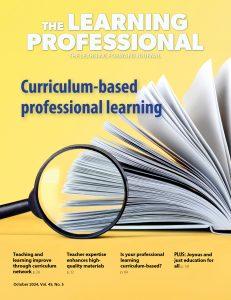“With Title IIA funding, we established an early intervention model for elementary, middle, and high school students who historically have had achievement gaps. At the elementary school, this resulted in those students meeting the state’s average for reading and math scores of students in that group. Our middle school students in that group outperformed the state reading proficiency goal in 2016, and our high school students in the same group outperformed the state percentage for Proficient/Distinguished students in Algebra II and English II. The high school has also moved from Persistently Low Achieving to a Distinguished School rating.”
An educator in Kentucky shared this story with Learning Forward when we asked our members to tell us how Title IIA funding helps them improve teaching and learning. I appreciate this particular example not only because of the great progress this district made in moving to a Distinguished School rating but more importantly because professional development ensured that educators could better serve students who are traditionally left behind.
I’m confident that, as a nation, we share a vision that all children deserve the opportunity to graduate high school ready for success in college, career, and life. For that to happen, policymakers have a responsibility to guarantee support for educators at every level. That’s why we’re asking Congress to include full funding for Title IIA in the federal budget.
Trump administration’s budget proposal slashes this funding to zero. Such cuts would harm schools and make it impossible for our nation to achieve the goals of excellence and equity established in the bipartisan Every Student Succeeds Act (ESSA). I find the proposal incredibly shortsighted if our intention is to create schools where every student has an equal opportunity to thrive.
While our colleagues in Kentucky describe a student intervention model, Title IIA funds are also used for leadership development. Educators in Louisiana report, “We use Title IIA funds to pay for leadership training for our principals and aspiring principals aligned to district goals for student improvement. With high-quality professional development, we have seen our district performance score move from 103 in 2013-14 to 109 in 2015-16.”
Title IIA funds are often also used to hire instructional coaches, as in an example we received from Colorado:
“We spend most of the Title IIA funds on salaries for teachers who function as coaches in the areas of new teacher induction programs, early literacy, RtI/MTSS support, data and assessment, next generation learning, new special education teachers. Providing job-embedded coaches allows teachers to learn side by side and doesn’t pull them from the classroom and away from students. We also see improvements in teacher retention: Teacher turnover has dropped from 15% to approximately 8%. Returning teachers attribute their continued service to the support they received during those crucial first three to five years.”
While such funds are used in a wide range of strategies, I’ve noticed one theme from among the more than 350 stories sent to Learning Forward: The professional learning that results in improvements in student learning aligns to the definition of professional development included in ESSA. Such learning is job-embedded, sustained, classroom-based, and collaborative. Whether the funds provide coaches who work side by side with teachers to adjust teaching strategies or external assistance providers who develop educators’ deep content knowledge tied to new materials, effective learning is grounded in the particular student learning needs and challenges of local educators. Let’s not undercut local districts’ ability to offer such valuable learning.
I’m hoping all educators will join Learning Forward and our colleagues at other education organizations in speaking up for Title IIA tomorrow — Wednesday, June 14. On this Day of Action, we’ll write our members of Congress, use social media to make our view known, and pick up the phone to request full funding for Title IIA. Visit www.lfstage.xyz/get-involved/advocacy/title-ii-advocacy for more specific guidance in advocating to support all educators.
This post originally appeared in Learning Forward’s PD Watch.






